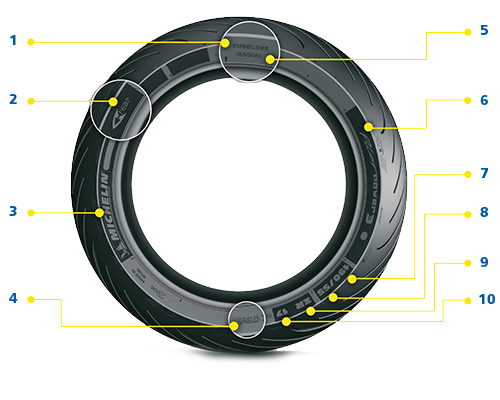Discover MICHELIN

1. Tubeless:
Indicates a tire that does not require an Inner tube. Tube type indicates a tire which does not require an Inner tube. Tube type indicates a tire which does not require an inner tube.
2. Rear:
The rear tire’s direction of rotation is indicated by an arrow on the sidewall
3. Michelin:
The name of the tire manufacturer
4. 73 Load index:
e.g. 73 indicates a maximum load of 365Kg per tire
5. Radial
6. Pilot power 3:
The tire’s catalogue name
7. 190:
The tire’s maximum section width in millimeters
8. SS:
Aspect ratio the sidewall height as a proportion of the section width
9. R:
Radial construction
10. 17:
The bead diameter in inches (1 inch = 2.54 cm)
Pressure: An essential factor in risk prevention.
Did you know that tire pressure significantly influences tire performance and safety?
Under-inflated tires cause extra flexing to the casing which consequently leads to heat-build-up, an increased rolling resistance and premature wear. Under-inflated tires can lead to damage.
Over-inflated tires can also lead to a drop in mileage potential. It reduces grip and increases irregular wear.
Never set pressure to match the number listed on a tire’s sidewall because that number is the maximum safe inflation pressure for the tire and has nothing to do with the recommendation for your vehicle.
It is recommended that you check your motorcycle tire pressure every two weeks and before a long journey. Always remember to check your pressure on cold tires (not used for at least 2 hours) in order to get an accurate pressure reading.
If the tires are warm when you check your pressure, add 0.3 bar to the recommended pressure.
By keeping your tires at the correct pressure, your tires will perform at their most effective, and will deliver the best returns of fuel economy, longevity and grip.
THE RISKS OF OVER- AND UNDER-INFLATION
Over-inflation:
- reduces comfort
- reduces grip
- Can lead to a drop in mileage potential
- Can increase irregular wear which can use more fuel
Under-inflation leads to:
- Extra flexing which consequently leads to heat build up an increase of rolling resistance and premature wear
- Damage and will use more fuel
To get the correct pressure, contact your motorcycle manufacturer or dealer.
CONVERSION CHART BAR / P.S.I / KPa
BAR |
PSI |
KPA |
ATM |
0,5 |
7 |
50 |
0.49 |
1 |
15 |
100 |
0.99 |
1.5 |
22 |
150 |
1.48 |
2 |
29 |
200 |
1.97 |
2.5 |
36 |
250 |
2.47 |
3 |
44 |
300 |
2.96 |
3.5 |
51 |
350 |
3.45 |
4 |
58 |
400 |
3.95 |
4.5 |
65 |
450 |
4.44 |
5 |
73 |
500 |
4.93 |
5.5 |
80 |
550 |
5.42 |
6 |
87 |
600 |
5.92 |
6.5 |
94 |
650 |
6.41 |
7 |
102 |
700 |
6.91 |
7.5 |
109 |
750 |
7.40 |
8 |
116 |
800 |
7.90 |
8.5 |
123 |
850 |
8.38 |
9 |
131 |
900 |
8.88 |
9.5 |
138 |
950 |
9.40 |
10 |
145 |
1000 |
9.87 |
You can check the size of your wheels in your handbook, or by checking the sidewall of your current tires.
The size code on the sidewall is translated like this:
190/55 R 17
190 – The width of the tire, when mounted in mm
55 – The height of the side as a percentage of the width
R – Denotes the tire is of Radial construction
17 – Is the diameter of the wheel size in inches (1 inch = 2.54 cm)
To prolong tire life, it is recommended to check them before each ride.
Remove all foreign objects trapped in the rubber with a small screwdriver.
Tires should be washed with water or MICHELIN approved cleaning products only as abrasive products may damage the tread or casing.
Tires should always be stored in a cool, dry, clean, indoor environment. If storage is for one month or more, eliminate the weight from the tires by raising the vehicle or by removing the tires from the vehicle. Failure to store tires in accordance with these instructions could result in damage to your tires or premature aging of the tires and sudden tire failure.